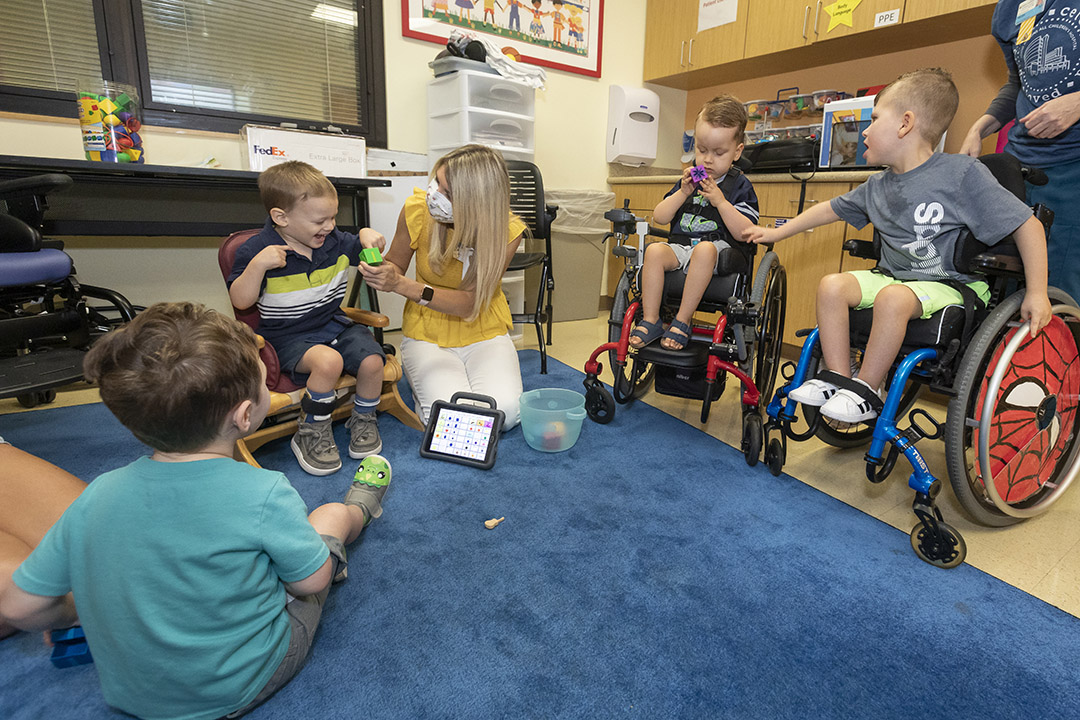A Preschool with A Special Purpose

Johns Hopkins All Children’s Hospital Augmentative and Alternative Communication (AAC) preschool language class.
Most parents look forward to that day when their child can start preschool. Often, it’s the first step in their independence. But some children have a disability, such as an expressive language delay. Their struggle to communicate with others can be a stressful time for the parents wanting to give their child some independence.
Fortunately, for these parents, Johns Hopkins All Children’s Hospital has developed an Augmentative and Alternative Communication (AAC) preschool language class. This program gives children ages 2-6, who cannot be introduced to a public school setting due to health or other concerns, a chance to learn to communicate through AAC devices within a specialized class or social setting. This helps them learn to interact with teachers and other children and build relationships through structured play, music, art and other motivating activities.
The program also helps the children learn to use an AAC device. This high-tech device looks similar to a tablet and helps a child with a speech or language impairment to communicate. The term AAC device is often used interchangeably with terms like speech-generating device (SGD) or assistive communication device or simply communication device.
Johns Hopkins All Children’s AAC Preschool Language Group is one of only a few programs of its kind in the State of Florida and across the country.
Patients are frequently referred to our hospital's program because of our unique care that includes not only the AAC Preschool Language Group, but our experience and ability to facilitate patients receiving speech-generating devices.
Funded through a generous grant from the Guinand Foundation, the weekly 90-minute class is conducted by two certified Johns Hopkins All Children’s pediatric speech-language pathologists. Each class features a theme with associated activities designed to target language use and social development. As many as seven children can participate in each class. Parents and caregivers will also be coached on how to help their child practice and grow their skills at home.
“These families know that we are equipped to work with their children’s special needs and try to make this preschool experience as much like a regular preschool as possible,” says Therese Montanari, director of speech-language pathology at Johns Hopkins All Children’s. “We can adapt the preschool components to meet the needs of the individual patient.”
The preschool program was good news for Jennifer, whose 4½-year-old son Joey was diagnosed with spinal muscular atrophy type 1.
“Within the first several months of his life, I just felt something was off,” Jennifer says. “He is my fifth baby. He wasn’t eating well and was making grunting sounds. After a series of tests that all came back normal, we thought we were in the clear. Then, we were referred to a neurologist who ran a variety of blood tests. The results came back as worst-case scenario.
“After Joey was diagnosed, we were told he would live 6-18 months,” Jennifer continues. “That was before Joey was accepted into a gene replacement therapy drug study when he was 4 months old. He was one of the first 25 children in the world to receive this therapy. Today, he is doing things we never thought he would do and, in a few months, he will be 5 years old.”
After a thorough speech language evaluation, it was determined that Joey was a perfect candidate for the AAC preschool program. But first, therapists had to figure out what AAC communication system would work best for him. In order to recommend the right speech device, they tried three or four different systems during his evaluation.
In Joey’s case, he learned to use an eye gaze technique where he focuses on an item on the device versus a touch screen. The device then speaks the word that Joey wants to say. His weekly therapy sessions focused on building his vocabulary, so he can communicate as a normal 4-year-old. And, because he has four older brothers at home, the language device was modified to use words specific to his family.
In addition to Joey’s therapy, Jennifer says the biggest benefit to her was the bond she built with the other parents who had children with similar issues at the preschool.
“Having Joey in this setting, I knew all the parents were in the same situation,” she says. “Many of us have bonded and formed our own informal support group. We do things with the other families outside of the hospital. This AAC preschool doesn’t just benefit Joey. It benefits us as parents, too.”
Montanari agrees that the amount of support the families have given each other was not anticipated when they wrote the business plan for the preschool program. “We were focused on the patients. We did not envision what an impact it would have on the parents,” she says.
For more information or to schedule a speech-language evaluation for your child, please call 727-767-4141.
